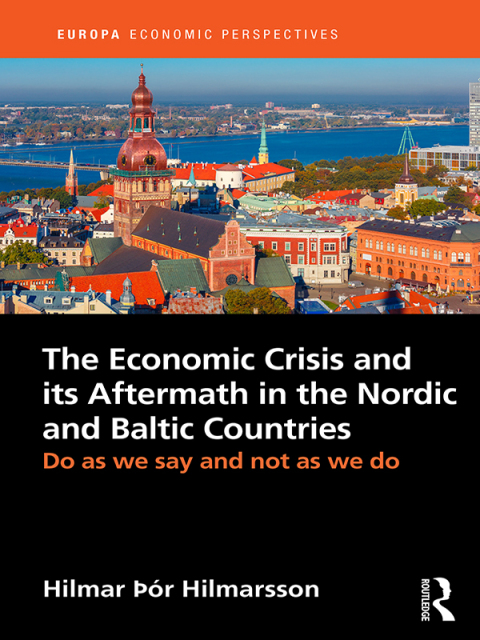Description
Efnisyfirlit
- Cover
- Half Title
- Title Page
- Copyright Page
- Table of Contents
- List of illustrations
- The Author
- Acknowledgements
- Preface
- Abbreviations and Acronyms
- Introduction
- Notes
- References
- 1. Theories employed and methodology applied in this book
- Notes
- References
- 2. Pre-crisis and post-crisis economic and social performance of the Nordic countries and the Baltic States: an overview
- Crisis response and the economic and social post-crisis consequences
- Welfare and tax systems in the Baltic States and Nordic countries compared: the links to Baltic austerity
- Austerity programmes in the Baltic States, human costs and long-term growth
- Banking, investment and trade linkages in the Nordic and Baltic region
- Notes
- References
- 3. The Nordic countries and the Baltic States—small states and multilateralism
- Definitions of ‘small states’
- Small states as a group
- Small states and multilateralism
- System-determining, -influencing, -affecting or -ineffectual
- Notes
- References
- 4. European integration and the Nordic-Baltic region, Schengen and NATO
- Free trade theories and economic integration
- Economic integration and security concerns
- Nordic-Baltic collective influence
- Notes
- References
- 5. Exchange rate policy: fixed or floating?
- The Baltics ‘go hard’ with a fixed exchange rate: reasons and consequences
- Does exchange rate policy matter for economic growth?
- Exchange rate regimes, the path to euro adoption and the decision to devalue
- Are fixed exchange rate regimes feasible?
- The Baltic ‘bubble’ versus Polish exceptionalism
- The crisis in Finland and Sweden in the early 1990s versus the Baltics in 2008/09
- Summing up: Sweden versus the Baltics
- The consequences of negative real interest rates
- Notes
- References
- 6. The challenges of euro area membership: Economic benefits versus security concerns, and the euro area versus NATO
- The absence of a currency devaluation option
- Currency union without fiscal union
- Excessive austerity
- The absence of a full banking union
- The European Central Bank
- The euro area and national security
- The Baltic States, NATO and reliance on the USA
- Notes
- References
- 7. Nordic–Baltic banking interconnectedness and its consequences
- Debt, public and private, pre- and post-crisis
- Notes
- References
- 8. International organizations as economic policy advisers for small states: the Baltics as victims?
- The Bretton Woods and EU institutions as advisors to EU member states
- Notes
- References
- 9. The Nordic welfare model and the Baltic States’ Anglo-Saxon bias
- Notes
- References
- 10. Fragile Baltic democracy and the challenges posed by outbound migration
- ‘Exit, Voice and Loyalty’
- Post-crisis recovery and performance
- Social and economic justice
- Notes
- References
- 11. The extreme cases of Iceland and Latvia during the global economic and financial crisis 1
- What does ownership mean for the International Monetary Fund? Some definitions
- Crisis response and ‘government ownership’ in Iceland and Latvia
- The global reaction to Iceland’s crisis
- Iceland’s dispute with the UK and the Netherlands
- EU desperation and the Scandinavian rush to ‘rescue’ Latvia
- The risks of Nordic-Baltic banking sector interconnectedness
- Economic growth and unemployment
- Social progress
- Measures of economic performance and social progress
- Going ‘beyond’ GDP when measuring ‘success’
- Poverty, social exclusion and income inequality in Latvia and Iceland
- Emigration
- Have the reform programmes in Iceland and Latvia been successful?
- Notes
- References
- 12. The Nordic–Baltic region: successes, failures, lessons learned and future challenges
- Crisis response, and the economic and social post-crisis consequences
- The consequences of Nordic-Baltic interlinkages
- The crisis in Sweden and Finland in the 1990s
- Tax and welfare systems and the consequences of austerity
- External challenges including further economic integration
- Challenges
- Challenges related to EU membership: a dysfunctional euro area?
- Notes
- References
- 13. The Nordic countries and the Baltic States—the need for further research
- Why did the Baltics adopt neoliberal policies post-independence, and what policy mix could help make them more inclusive?
- How can the Baltics promote business development and better share the benefits?
- How can the Baltics become more democratic and achieve more circular flows of people instead of showing a tendency to one-way exodus?
- What can the Baltics do to improve cohesion within their borders in order to improve their internal security during a time of growing external uncertainty?
- How can small states reduce their vulnerability in their dealings with international organizations?
- The Nordics have been very active in international development co-operation. How can the Baltics contribute more to development most notably in less advanced transition countries?
- How do foreign banks (mostly Nordic in the case of the Baltic States) influence the policy stance of governments as well as international organizations?
- How can the Baltics better diversify the ownership of their banking sector to reduce cross-border Nordic-Baltic vulnerabilities?
- How can the Baltics develop a more vibrant export sector?
- What level of global integration serves the long-term interest of the Baltics?
- How can small states benefit from international organizations, obtain shelter and avoid vulnerabilities?
- What policy mix, most notably in fiscal policy, is most suitable for small transition countries within the EU?
- Note
- References
- Index







Reviews
There are no reviews yet.